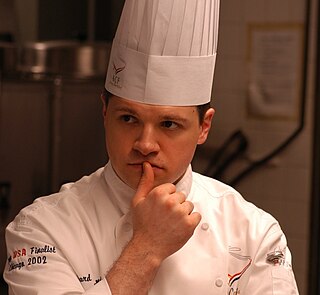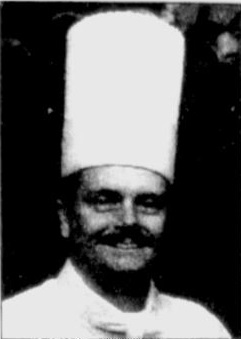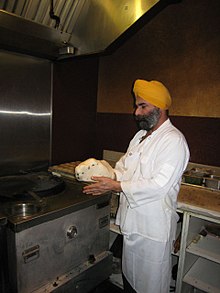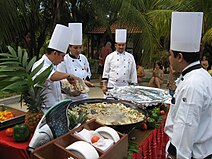
French cuisine is the cooking traditions and practices from France. In the 14th century, Guillaume Tirel, a court chef known as "Taillevent", wrote Le Viandier, one of the earliest recipe collections of medieval France. In the 17th century, chefs François Pierre La Varenne and Marie-Antoine Carême spearheaded movements that shifted French cooking away from its foreign influences and developed France's own indigenous style.

Haute cuisine or grande cuisine is a style of cooking characterised by meticulous preparation, elaborate presentation, and the use of high quality ingredients. Typically prepared by highly skilled gourmet chefs, haute cuisine dishes are renowned for their high quality and are often offered at premium prices.

Georges Auguste Escoffier was a French chef, restaurateur, and culinary writer who popularized and updated traditional French cooking methods. Much of Escoffier's technique was based on that of Marie-Antoine Carême, one of the codifiers of French haute cuisine; Escoffier's achievement was to simplify and modernize Carême's elaborate and ornate style. In particular, he codified the recipes for the five mother sauces. Referred to by the French press as roi des cuisiniers et cuisinier des rois, Escoffier was a preeminent figure in London and Paris during the 1890s and the early part of the 20th century.
A sous-chef is a chef who is second in command of a kitchen, ranking directly below the head chef. In large kitchens, sous-chefs generally manage members of the kitchen on behalf of the head chef, who is usually preoccupied with other tasks.

California cuisine is a food movement that originated in Northern California. The cuisine focuses on dishes that are driven by local and sustainable ingredients with an attention to seasonality and an emphasis on the bounty of the region.

Jacques Pépin is a French chef, author, culinary educator, television personality, and artist. After having been the personal chef of French President Charles de Gaulle, he moved to the US in 1959 and after working in New York's top French restaurants, refused the same job with President John F. Kennedy in the White House and instead took a culinary development job with Howard Johnson's. During his career, he has served in numerous prestigious restaurants, first, in Paris, and then in America. He has appeared on American television and has written for The New York Times, Food & Wine and other publications. He has authored more than 30 cookbooks, some of which have become best sellers. Pépin was a longtime friend of the American chef Julia Child, and their 1999 PBS series Julia and Jacques Cooking at Home won a Daytime Emmy Award. He also holds a BA and a MA from Columbia University in French literature.

A cook is a professional individual who prepares items for consumption in the food industry, especially in settings such as restaurants. A cook is sometimes referred to as a chef, although in the culinary world, the terms are not interchangeable. Cooks' responsibilities include preparing food, managing food stations, cleaning the kitchen, and helping the chefs. Restaurants will give a title to the cooks according to their designated stations. Examples are broiler cooks, fry cooks, pantry cooks, and sauce cooks.

Iron Chef America is an American cooking show based on Fuji Television's Iron Chef, and is the second American adaptation of the series, following the failed Iron Chef USA that aired in 2001. The show is produced by Food Network, which also carried a dubbed version of the original Iron Chef. Like the original Japanese program, the program is a culinary game show. In each episode, a new challenger chef competes against one of the resident "Iron Chefs" in a one-hour cooking competition based on a secret ingredient or ingredients, and sometimes theme.
Walter Stanley Scheib III was an American chef who was White House Executive Chef from 1994 until 2005.
Brigade de cuisine is a system of hierarchy found in restaurants and hotels employing extensive staff, commonly referred to as "kitchen staff" in English-speaking countries.

A chef de cuisine or head chef is a chef that leads a kitchen and its cooks. A chef patron or executive chef is a chef that manages multiple kitchens and their staff.
Jun Tanaka is an American-born Japanese-British television chef, best known for presenting Channel 4's Cooking It as well as appearing in Saturday Kitchen on BBC One. He was the third Grand Champion of the American competitive cooking show, Chopped.
Staging is an unpaid internship test when a cook or chef works briefly for free in another chef's kitchen to learn and be exposed to new techniques and cuisines.

Christina Machamer is an American chef who won in the fourth season of Fox Network's reality cooking show Hell's Kitchen. She was awarded the position of "senior sous chef" at Gordon Ramsay's then-new restaurant at The London West Hollywood, where she earned a $250,000 yearly salary.
Marc Thuet is a chef based in Toronto, Ontario, Canada, who most recently appeared in his second season of a docu-reality TV series called Conviction Kitchen in which he trains 12 ex-cons to run a restaurant in Toronto.
The Bocuse d'Or USA is a biennial chef championship, where the winner is selected to represent the U.S. in the international Bocuse d'Or competition. Following 20 years of American representation in the competition, in 2008 Paul Bocuse asked Daniel Boulud to establish a structure for the selection of Team USA, who along with Thomas Keller and Jérôme Bocuse form the Board of Directors of the Bocuse d'Or USA Foundation. The first Bocuse d'Or USA competition was held in September 2008.

Richard Rosendale is an American chef. He was the U.S. candidate selected to perform at the international Bocuse d'Or 2013 in France.
Note by Note cuisine is a style of cooking based on molecular gastronomy, created by Hervé This. Dishes are made using pure compounds instead of using animal or plant tissues. This said the cuisine is like "a painter using primary colours, or a musician composing electroacoustic music, wave by wave, using a computer".
Jean Baptiste Molinari is a French head chef, who worked as an executive chef at Dromoland Castle in Newmarket-on-Fergus, County Clare, Ireland, and now is chef de cuisine at Compass Group, a British food contracting service. He won a Michelin star in 1995.

Jon Hill is an American chef who was White House Executive Chef from October 1, 1987, to January 7, 1988. He was the first American-born chef to serve in the capacity.



















